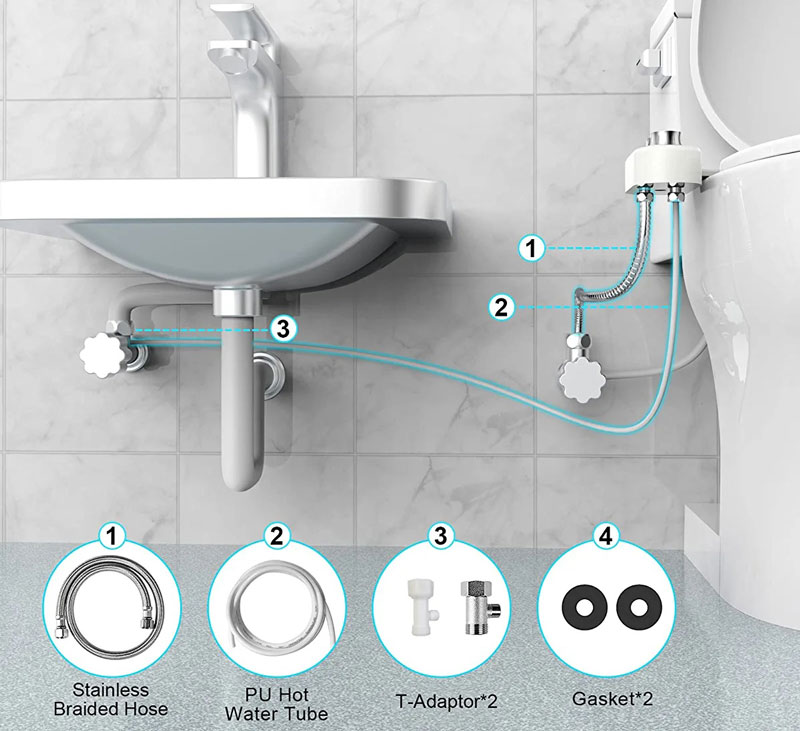A simple bidet attachment saves the waste of toilet paper and reduces the expenses spent on them. Most users prefer buying electric and non-electric toilet seats. But the problem is that non-electric bidets don’t come with hot water facilities. You have to connect the warm water pipeline manually. So, how to connect the bidet to hot water?
The installation is simple, and you don’t need plumbers’ help. First, bring essential tools like an Adjustable wrench, Teflon tape, and a water hose with 1/2″. The second step is to shut off the current water supply and connect to your hot water source. Indeed, the process is simple, but you have to go in step by step.
This guide gives you all the tools, precautions, and processes to connect the bidet to hot water. So, without wasting time, let’s get started.
Related Post: Top 10 Best Bidet Converter Kits to Choose for Your Toilet
How To Connect a Bidet to Hot water?
Before starting the installation, note down a few tips. Not all non-electric bidets come with additional hot water connections. So you have to buy a seat that has such an option. Secondly, you should add a warm water source or tank before connecting the bidet. Thirdly, follow a step-by-step process to bring accuracy to your installation.
1. Gather Necessary Tools
You don’t need professional skills to connect the bidet to a hot water supply. However, you should bring some plumber’s tools to start the installation. Below are the equipment required for this task.
- Adjustable wrench to tighten or loosen any nuts require in the process
- Teflon tape allows closing any leakage or additional close-up in the pipeline
- Water hose with 1/2″ that connects the water supply to your bidet seat
- A screwdriver for further adjustment
2. Location of Your Hot Water Source
Before connecting the bidet to hot water, you should know where the supply line is located. Besides, a few precautions should be noted while performing the task.
- You should have a “Y” or “T” valve to connect a Non-electric bidet to the water supply pipe
- Hot water pipes are mainly located behind the toilet or under the sink
If you have an electric bidet seat that allows instant warm water or a night light facility, you should have an electric outlet
- An electric outlet in wet places should be protected by a ground fault circuit interrupter (GFCI)
- If your outlet doesn’t have the protection or you are not sure, contact a plumber
3. Shut Off The Water Supply
Now it’s time to start connecting your bidet to a hot water source. To begin the process, first shut off the water supply
- The connection is located just behind your toilet
- Rotate the knob clockwise so the water supply will stop
- Flush the toilet tank unit. It became empty
- Wait a while to double check
4. Connect the Flexible Water Hose
As mentioned, your non-electric seat should have an additional warm water port. So that you can connect the bidet to hot water using a hose. Below are the steps to complete the connection
- Use an adjustable wrench and disconnect the water hose located at the base of the tank
- Rotate the tool anticlockwise to remove the supply line
- Bring a “T” or “Y” valve and wrap the connectors with Teflon tape (optional)
- Connect it at the base of your tank using a wrench
- Rotate clockwise to secure it
- Attach the bidet water hose to the upper side of the valve
- Connect its other end to your seat
- Connect the warm water hose to the end of your “T” valve connector.
Some users also prefer to connect the hot water supply hose directly to the additional port available in the seat. You can also connect the bidet to warm water by following this step. In this situation, you should avoid previously discussed steps.
5. Turn the Hot Water Supply
Now it’s time to turn on the warm water supply and ensure the delivery. Suppose the adjustment is accurate; no problem you face. Still, you should perform certain test connections by following the below steps.
6. Test Connection
After connecting your bidet to a warm water supply, consider some test connections.
- Look for any leakage of pipe
- If you find any damage, use Teflon tape to block
- Rotate anticlockwise to loosen the connection
- Rotate clockwise to tighten the bolts
- Press your hand on the bidet seat to ensure proper installation
- Take note of the cold and warm water supply in your bidet
- Check if the spray nozzle works properly
- Go through each bolt and connection to ensure well attached
So that’s the complete process to connect your non-electric bidet seat to a warm water supply. You may also check the following video for better understanding.
FAQs
How to Connect Bidet to Cold Water?
Connecting a bidet seat to cold water, follow our discussed steps above. Firstly disconnect the water hose from the tank and add a “T” valve. Connect the bidet hose to one end of the valve and the other to the cold water supply.
Where Does Bidet Water Come From?
Bidet water directly comes from your home water supply. Ths toilet seat drives the water from your main pipeline. Indeed, water directly comes to the bidet seat before going to the toilet tank. So your bidet doesn’t use tank water to wash your rare body parts.
Conclusion
Your non-electric bidet should have an additional warm water port or option to complete the connection. Indeed, most bidets come with a standard cold water supply port. So if you have the extra option, follow our step-by-step guide to connect it. Tushy, renook, Luxe, etc such brands provide some best non-electric bidets with the following facilities. You can check them and enjoy warm water without investing in electric models
Recommended Posts














